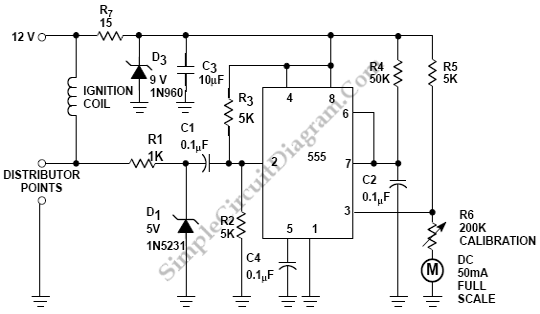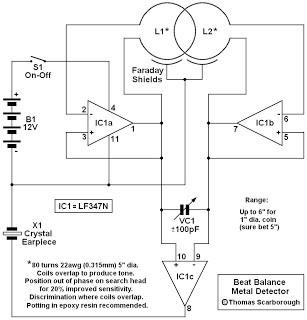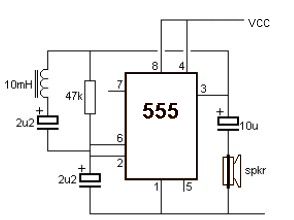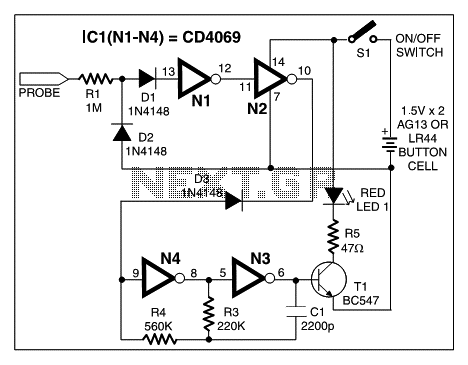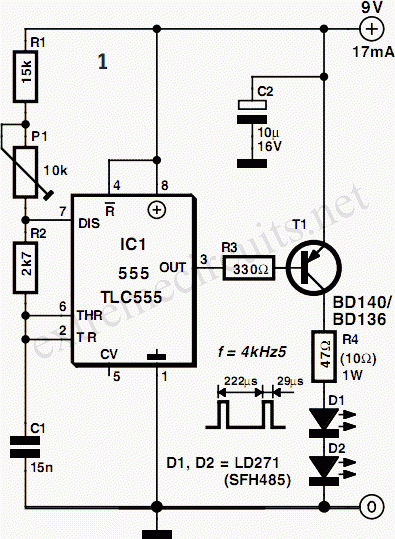
555 capacitance frequency transistor-line detector
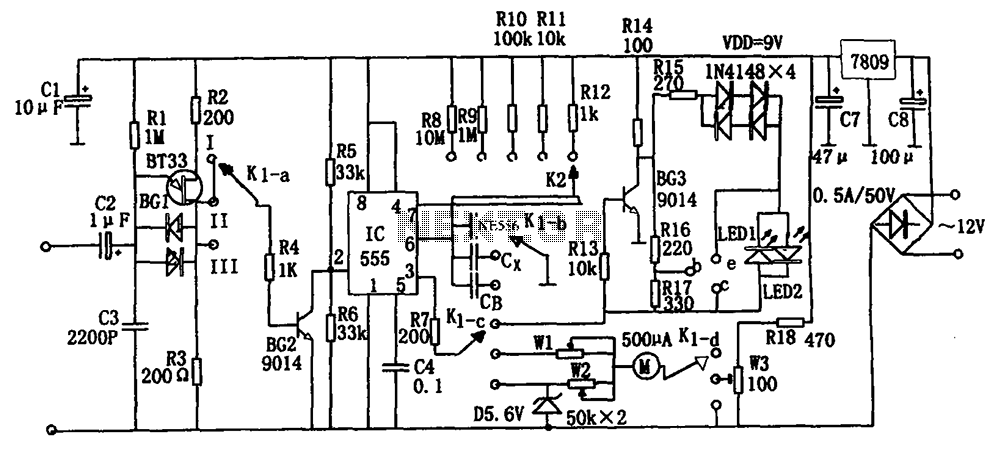
The frequency detection circuit utilizes a transistor line, adjustable via a preset switch K1, to convert capacitance and frequency measurements. The K1 switch is positioned to detect capacitance. The circuit comprises components including a 555 timer, resistors R8 to R12, and a measured capacitance Cx. As the capacitance Cx increases, the pulse width (td) also increases, specifically following the formula td = 1.1 (R8 ~ R12) Cx, resulting in a higher average current which indicates a corresponding increase in the output signal. The circuit includes a single junction transistor BG1 in conjunction with R1 and C3, forming a relaxation oscillator. The output pulse signal from this oscillator serves as a trigger pulse for the integrated circuit (IC). K1 can also be set for frequency measurements, producing a fixed output signal width of td = 1.1 (R8 ~ R12) CB. As the frequency of the input signal increases, the IC is triggered more frequently, resulting in a greater average current and a corresponding increase in the output signal. K1 can be used for online testing of transistors, with a principle akin to capacitor detection. The circuit ensures positive and negative power conversion through transistor BG1, with the IC output alternating between high and low states. If the light-emitting diodes LED1 and LED2 illuminate, the transistor is functioning correctly; if not, the transistor is defective.
The described frequency detection circuit is an essential tool for measuring capacitance and frequency through a systematic approach involving a relaxation oscillator and a transistor testing mechanism. The use of a 555 timer provides a stable timing reference, while the adjustable resistors R8 to R12 allow for fine-tuning of the pulse width in relation to the measured capacitance Cx. The incorporation of the K1 switch facilitates user interaction, enabling the selection of measurement modes—either capacitance detection or frequency measurement.
In the capacitance measurement mode, the circuit's design ensures that as the capacitance increases, the output pulse width also extends, which can be directly correlated to the average output current. This characteristic is crucial for applications requiring precise capacitance values. The relaxation oscillator formed by BG1, R1, and C3 generates a consistent pulse train that serves as the triggering mechanism for the IC, ensuring reliable operation.
When measuring frequency, the circuit maintains a fixed output width, allowing for consistent readings across varying input signal frequencies. This feature is particularly valuable in applications where frequency stability is critical. The online transistor testing functionality provides a straightforward means of assessing transistor health, with LED indicators offering instant feedback on operational status.
Overall, this frequency detecting circuit exemplifies a well-integrated design that combines capacitance measurement, frequency analysis, and transistor testing into a single, versatile platform, making it an invaluable asset in electronic testing and diagnostics. The design principles employed ensure robustness and reliability, catering to a range of electronic applications. As shown for the capacitor, the frequency detecting circuit transistor line. Can be converted by adjusting the preset switch K1 when this detector capacitance, frequency, trans istor testing. The K1 placed II detectable capacitance. 555 and R8 ~ R12 and measured capacitance Cx composition single stabilizing circuit, Cx capacity is increased, the pulse width, ie td 1.1 (R8 ~ R12) Cx longer, the greater the current average, indicating that the corresponding header greater. Circuit BG1 single junction transistor with R1, C3 composition relaxation oscillator, the oscillation output pulse signal as a trigger pulse of the IC.
The K1 placed III frequency measurements can be carried out. At this one-shot circuit IC output td signal 1.1 (R8 ~ R12) CB fixed value width. The higher the frequency of the input signal. Frequency IC is triggered, the more the greater the average current, the greater the corresponding table header indicates. The K1 place I can be online test transistor. The principle is similar to the detection capacitor. Circuit transistor BG1 complete positive and negative power conversion. With IC output high and low alternating changes, if the light-emitting diodes LED1, LED2 turn light, then the transistor is good, otherwise the transistor is bad.
The described frequency detection circuit is an essential tool for measuring capacitance and frequency through a systematic approach involving a relaxation oscillator and a transistor testing mechanism. The use of a 555 timer provides a stable timing reference, while the adjustable resistors R8 to R12 allow for fine-tuning of the pulse width in relation to the measured capacitance Cx. The incorporation of the K1 switch facilitates user interaction, enabling the selection of measurement modes—either capacitance detection or frequency measurement.
In the capacitance measurement mode, the circuit's design ensures that as the capacitance increases, the output pulse width also extends, which can be directly correlated to the average output current. This characteristic is crucial for applications requiring precise capacitance values. The relaxation oscillator formed by BG1, R1, and C3 generates a consistent pulse train that serves as the triggering mechanism for the IC, ensuring reliable operation.
When measuring frequency, the circuit maintains a fixed output width, allowing for consistent readings across varying input signal frequencies. This feature is particularly valuable in applications where frequency stability is critical. The online transistor testing functionality provides a straightforward means of assessing transistor health, with LED indicators offering instant feedback on operational status.
Overall, this frequency detecting circuit exemplifies a well-integrated design that combines capacitance measurement, frequency analysis, and transistor testing into a single, versatile platform, making it an invaluable asset in electronic testing and diagnostics. The design principles employed ensure robustness and reliability, catering to a range of electronic applications. As shown for the capacitor, the frequency detecting circuit transistor line. Can be converted by adjusting the preset switch K1 when this detector capacitance, frequency, trans istor testing. The K1 placed II detectable capacitance. 555 and R8 ~ R12 and measured capacitance Cx composition single stabilizing circuit, Cx capacity is increased, the pulse width, ie td 1.1 (R8 ~ R12) Cx longer, the greater the current average, indicating that the corresponding header greater. Circuit BG1 single junction transistor with R1, C3 composition relaxation oscillator, the oscillation output pulse signal as a trigger pulse of the IC.
The K1 placed III frequency measurements can be carried out. At this one-shot circuit IC output td signal 1.1 (R8 ~ R12) CB fixed value width. The higher the frequency of the input signal. Frequency IC is triggered, the more the greater the average current, the greater the corresponding table header indicates. The K1 place I can be online test transistor. The principle is similar to the detection capacitor. Circuit transistor BG1 complete positive and negative power conversion. With IC output high and low alternating changes, if the light-emitting diodes LED1, LED2 turn light, then the transistor is good, otherwise the transistor is bad.
